 WeChat Applet
WeChat Applet
 WeChat Development
WeChat Development
 Force.com WeChat development series applies for test accounts and responds to graphic messages
Force.com WeChat development series applies for test accounts and responds to graphic messages
Force.com WeChat development series applies for test accounts and responds to graphic messages
In addition to simple text message replies, Force.com can also reply to messages with pictures and texts, reply to music or videos, recognize voices sent by users, collect users' geographical location information and provide corresponding content or Services, etc., this article will explain these skills one by one. Before that, we must first introduce how to apply for a test account with all service account interface functions (although this is not necessary for replying to graphic messages).
Apply for a test account
As an individual developer, you can apply for a subscription account. The subscription account only opens the basic interface, including receiving user messages, replying to users, and Accept events (event push has follow or unfollow, scan QR code with parameters (generating such QR code requires advanced interface), report geographical location (not supported by ordinary subscription account), custom menu (not supported by ordinary subscription account) ) click) push three interfaces, but advanced functions such as custom menus, speech recognition, customer service interfaces, OAuth2.0 web page authorization, obtaining user geographical location information, etc. all require service accounts to support, among which certified subscription accounts Support custom menu. In order to facilitate developers to understand and learn these interfaces of Tencent, like any platform company, Tencent finally opened applications for test accounts late last year. Anyone with a WeChat subscription account can apply (a service account should also be possible, but I haven’t seen what the backend of a service account looks like, so I won’t comment).
The application method is simple and direct. After entering the WeChat backend (https://mp.weixin.qq.com), there is a After clicking on the "Developer Center" link, you will find a link to "Interface Test Application System Click to Enter". After clicking to enter, you can apply according to Tencent's ideas. I will not go into details here.
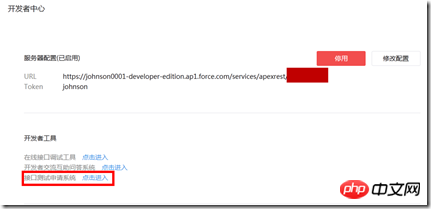
What the application will look like after successful login is as follows. You can see it here. You can also see a two when scrolling the page. QR code, scan this QR code through WeChat to follow this test account, which supports up to 20 test users. After successful follow-up, there will be an additional account called "WeChat Public Platform Test Account" in the WeChat "Subscription Account" folder , note that although it is in the "Subscription Account" folder, it has the functions of all service accounts:
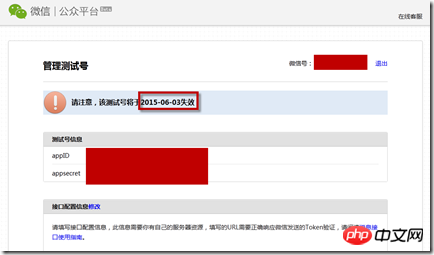 For the next work, here we first build several key classes and corresponding processing frameworks to facilitate the subsequent addition of more functional support.
For the next work, here we first build several key classes and corresponding processing frameworks to facilitate the subsequent addition of more functional support. 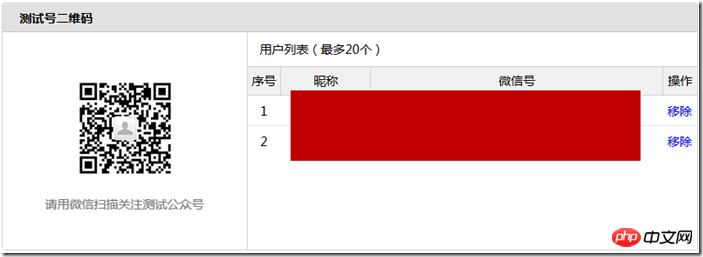
public class IncomingMsg{
public String toUserName;
public String fromUserName;
public String msgType;
public String picURL;
public String mediaID;
public String locationX;
public String locationY;
public String URL;
public String content;
public String event;
public String eventKey;
public String recognition;
public IncomingMsg(){}
public IncomingMsg(String tUN, String fUN, String mT, String pU, String mI, String lX, String lY, String u, String c, String e, String eK, String r){
this.toUserName = tUN;
this.fromUserName = fUN;
this.msgType = mT;
this.picURL = pU;
this.mediaID = mI;
this.locationX = lX;
this.locationY = lY;
this.URL = u;
this.content = c;
this.event = e;
this.eventKey = eK;
this.recognition = r;
}
}public class WeChatNews{
public String title;
public String description;
public String picUrl;
public String url;
public WeChatNews(){}
public WeChatNews(String t, String d, String p, String u){
this.title = t;
this.description = d;
this.picUrl = p;
this.url = u;
}
}global static void doPost(){
//Receive message from user;
RestRequest req = RestContext.request;
RestResponse res = RestContext.response;
string strMsg = req.requestBody.toString();
System.debug('Request Contents' + strMsg);
XmlStreamReader reader = new XmlStreamReader(strMsg);
String toUserName = '';
String fromUserName = '';
String msgType = '';
String picURL = '';
String mediaID = '';
String locationX = '';
String locationY = '';
String URL = '';
String content = '';
String msgID = '';
String event = '';
String eventKey = '';
String recognition = '';
while(reader.hasNext()){
if(reader.getLocalName() == 'ToUserName'){
reader.next();
if(String.isNotBlank(reader.getText())){
toUserName = reader.getText();
}
}
else if(reader.getLocalName() == 'FromUserName'){
reader.next();
if(String.isNotBlank(reader.getText())){
fromUserName = reader.getText();
}
}
else if(reader.getLocalName() == 'MsgType'){
reader.next();
if(String.isNotBlank(reader.getText())){
msgType = reader.getText();
}
}
else if(reader.getLocalName() == 'PicURL'){
reader.next();
if(String.isNotBlank(reader.getText())){
picURL = reader.getText();
}
}
else if(reader.getLocalName() == 'MediaId'){
reader.next();
if(String.isNotBlank(reader.getText())){
mediaID = reader.getText();
}
}
else if(reader.getLocalName() == 'Location_X'){
reader.next();
if(String.isNotBlank(reader.getText())){
locationX = reader.getText();
}
}
else if(reader.getLocalName() == 'Location_Y'){
reader.next();
if(String.isNotBlank(reader.getText())){
locationY = reader.getText();
}
}
else if(reader.getLocalName() == 'Url'){
reader.next();
if(String.isNotBlank(reader.getText())){
URL = reader.getText();
}
}
else if(reader.getLocalName() == 'MsgId'){
reader.next();
if(String.isNotBlank(reader.getText())){
msgID = reader.getText();
}
}
else if(reader.getLocalName() == 'Content'){
reader.next();
if(String.isNotBlank(reader.getText())){
content = reader.getText();
}
}
else if(reader.getLocalName() == 'Event'){
reader.next();
if(String.isNotBlank(reader.getText())){
event = reader.getText();
}
}
else if(reader.getLocalName() == 'EventKey'){
reader.next();
if(String.isNotBlank(reader.getText())){
eventKey = reader.getText();
}
}
else if(reader.getLocalName() == 'Recognition'){
reader.next();
if(String.isNotBlank(reader.getText())){
recognition = reader.getText();
}
}
reader.next();
}
IncomingMsg inMsg = new IncomingMsg(toUserName, fromUserName, msgType, picURL, mediaID, locationX, locationY, URL, content, event, eventKey, recognition );
}String rtnMsg = '';
//回复消息
if(msgType.equals('text')){
rtnMsg = handleText(inMsg);
}
RestContext.response.addHeader('Content-Type', 'text/plain');
RestContext.response.responseBody = Blob.valueOf(rtnMsg);
This code first defines a String that stores the returned XML text. string, and then determine if the message type sent by the user is a text type, then call a handleText method to process the reply message. The object passed to the handleText method here is the IncomingMsg object we defined earlier. We will discuss the details of this method below. This section will introduce it again. After successfully obtaining the return string of this method, the XML text message can be returned to Tencent WeChat through RestContext, and further returned to the user who sent the message.
Detailed explanation of handleText method for sending images and text
private static String handleText(IncomingMsg msg){
String keyword = msg.content;
String strReply;
String strResult;
if(keyword.equals('文本')){
strReply = '这是个文本消息';
strResult = composeTextReply(msg, strReply);
}
else if(keyword.equals('图文') || keyword.equals('单图文')){
WeChatNews news = new WeChatNews('苹果WWDC2014召开在即', '2014 年似乎将成为又一个“苹果之年”,热爱和不那么热爱苹果的人都对它的一举一动保持着关注和揣测——以下是苹果 WWDC 2014 的13大看点:', 'http://a.36krcnd.com/photo/2014/4e3ae0dac4884bb91934a689b72f8f8b.png', 'http://www.36kr.com/p/212479.html');
List<wechatnews> newsList = new List<wechatnews>();
newsList.add(news);
strResult = composeNewsReply(msg, newsList);
}
else if(keyword.equals('多图文')){
WeChatNews news1 = new WeChatNews('苹果WWDC2014召开在即', '2014年似乎将成为又一个苹果之年,热爱和不那么热爱苹果的人都对它的一举一动保持着关注和揣测——以下是苹果 WWDC 2014 的13大看点:', 'http://a.36krcnd.com/photo/2014/4e3ae0dac4884bb91934a689b72f8f8b.png', 'http://www.36kr.com/p/212479.html');
WeChatNews news2 = new WeChatNews('Facebook CEO 马克·扎克伯格再做慈善,为湾区学校捐赠 1.2 亿美元', '据 re/code消息,Facebook CEO 马克·扎克伯格与妻子Priscilla Cha (中文名陈慧娴) 计划向湾区学校捐赠 1.2 亿美元。', 'http://a.36krcnd.com/photo/2014/e64d647389bfda39131e12fa9d606bb6.jpg', 'http://www.36kr.com/p/212476.html');
WeChatNews news3 = new WeChatNews('Nokia收购Siri的同门师弟Desti,为自家地图业务HERE融入更多人工智能', 'Nokia最近收购了一家地图公司Desti,来补强自家的地图业务HERE。', 'http://a.36krcnd.com/photo/2014/25490e2b8e63ced9586f0a432eebb972.jpg', 'http://www.36kr.com/p/212484.html');
List<wechatnews> newsList = new List<wechatnews>();
newsList.add(news1);
newsList.add(news2);
newsList.add(news3);
strResult = composeNewsReply(msg, newsList);
}
else if(keyword.equals('音乐')){
Map<string> music = new Map<string>();
music.put('title', '爱你的宿命');
music.put('description', '张信哲');
music.put('musicUrl', 'http://zhangmenshiting.baidu.com/data2/music/119826740/1197655931401552061128.mp3?xcode=80587c819993d49621a8dce05e5bb8c9e36664380262dc7e&song_id=119765593');
music.put('musicHQUrl', 'http://zhangmenshiting.baidu.com/data2/music/119826740/1197655931401552061128.mp3?xcode=80587c819993d49621a8dce05e5bb8c9e36664380262dc7e&song_id=119765593');
strResult = composeMusicReply(msg, music);
}
return strResult;
}</string></string></wechatnews></wechatnews></wechatnews></wechatnews>代码的思路应该来说比较直接,从第4行的if开始判断用户发送过来的文本是什么,根据不同的关键字来确定不同的返回内容,第一个if里将返回给用户单图文信息,这里先构造了一个WeChatNews数组,当然数组里只有一个WeChatNews对象,将这个数组交给composeNewsReply来完成最终的XML文构建;第一个else if也很类似,只不过这里的WeChatNews数组里有三条新闻,关于composeNewsReply方法的细节我们稍后介绍;最后一个else if里展示了如何回复音乐,这里我们构建了一个Map对象存储音乐的详情,并调用composeMusicReply方法来完成最终的XML文构建,同样该方法的细节稍后就会介绍到。
上面的思路应该来说还是比较清楚的,接下来介绍composeNewsReply方法的全部代码:
private static String composeNewsReply(IncomingMsg msg, List<wechatnews> newsList){
String strNews = '';
String newsTpl = '<item><title></title>
<description></description><picurl></picurl><url></url></item>';
for(WeChatNews news : newsList){
String[] arguments = new String[]{news.title, news.description, news.picUrl, news.url};
strNews += String.format(newsTpl, arguments);
}
String strTmp = '<xml><tousername></tousername><fromusername></fromusername><createtime>1234567890</createtime><msgtype></msgtype><articlecount></articlecount><articles>' + strNews + '</articles></xml>';
String[] arguments = new String[]{msg.fromUserName, msg.toUserName, String.valueOf(newsList.size())};
String results = String.format(strTmp, arguments);
return results;
}</wechatnews>
了解该方法代码前先要了解回复图文信息的XML格式,关于此点可以参照腾讯公司链接:回复图文消息 ,与前文介绍到的普通文本消息大同小异,可以留意到里面有个ArticleCount字段用来指定回复的消息里能有几条图文新闻,最大是10,超过10则会无法响应;另外Article节点下方每一个item均是一条图文消息。为此,上述代码的第3行先构造一个每条新闻的模板,接着从第4行开始轮询新闻列表里的每一条新闻,并构造相应的XML文。从第8行开始构造整个图文回复的字符串模板,并在第9、10行通过相应参数将模板转换为最终的XML字符串。
再接下来介绍composeMusicReply,该方法的全部代码如下:
private static String composeMusicReply(IncomingMsg msg, Map<string> music){
String strTitle = music.get('title');
String strDesc = music.get('description');
String strURL = music.get('musicUrl');
String strHQURL = music.get('musicHQUrl');
String musicTpl = '<xml><tousername></tousername><fromusername></fromusername><createtime>12345678</createtime><msgtype></msgtype><music><title></title>
<description></description><musicurl></musicurl><hqmusicurl></hqmusicurl></music></xml>';
String[] arguments = new String[]{msg.fromUserName, msg.toUserName, strTitle, strDesc, strURL, strHQURL};
String results = String.format(musicTpl, arguments);
return results;
}</string>同样了解该方法要首先了解回复音乐信息的XML格式,可以参照腾讯公司链接:回复音乐消息,上面代码与前面方法比较类似,就不再赘述。(这里的Map对象也许有点多余,可以考虑是否可以和回复视频的方法整合到一起,否则不需要额外的Map对象开销,直接将标题、描述、链接等信息传给composeMusicReply方法即可)。
运行效果
完成后直接保存代码便可立即生效,回复图文、多图文、音乐的运行效果分别如下:
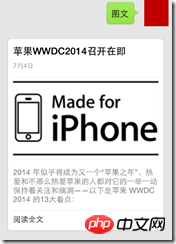

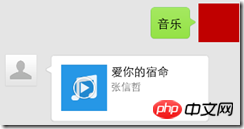
更多Force.com WeChat development series applies for test accounts and responds to graphic messages相关文章请关注PHP中文网!

Hot AI Tools

Undresser.AI Undress
AI-powered app for creating realistic nude photos

AI Clothes Remover
Online AI tool for removing clothes from photos.

Undress AI Tool
Undress images for free

Clothoff.io
AI clothes remover

AI Hentai Generator
Generate AI Hentai for free.

Hot Article

Hot Tools

Notepad++7.3.1
Easy-to-use and free code editor

SublimeText3 Chinese version
Chinese version, very easy to use

Zend Studio 13.0.1
Powerful PHP integrated development environment

Dreamweaver CS6
Visual web development tools

SublimeText3 Mac version
God-level code editing software (SublimeText3)

Hot Topics
 1378
1378
 52
52
 PHP WeChat development: How to implement message encryption and decryption
May 13, 2023 am 11:40 AM
PHP WeChat development: How to implement message encryption and decryption
May 13, 2023 am 11:40 AM
PHP is an open source scripting language that is widely used in web development and server-side programming, especially in WeChat development. Today, more and more companies and developers are starting to use PHP for WeChat development because it has become a truly easy-to-learn and easy-to-use development language. In WeChat development, message encryption and decryption are a very important issue because they involve data security. For messages without encryption and decryption methods, hackers can easily obtain the data, posing a threat to users.
 Using PHP to develop WeChat mass messaging tools
May 13, 2023 pm 05:00 PM
Using PHP to develop WeChat mass messaging tools
May 13, 2023 pm 05:00 PM
With the popularity of WeChat, more and more companies are beginning to use it as a marketing tool. The WeChat group messaging function is one of the important means for enterprises to conduct WeChat marketing. However, if you only rely on manual sending, it is an extremely time-consuming and laborious task for marketers. Therefore, it is particularly important to develop a WeChat mass messaging tool. This article will introduce how to use PHP to develop WeChat mass messaging tools. 1. Preparation work To develop WeChat mass messaging tools, we need to master the following technical points: Basic knowledge of PHP WeChat public platform development Development tools: Sub
 PHP WeChat development: How to implement user tag management
May 13, 2023 pm 04:31 PM
PHP WeChat development: How to implement user tag management
May 13, 2023 pm 04:31 PM
In the development of WeChat public accounts, user tag management is a very important function, which allows developers to better understand and manage their users. This article will introduce how to use PHP to implement the WeChat user tag management function. 1. Obtain the openid of the WeChat user. Before using the WeChat user tag management function, we first need to obtain the user's openid. In the development of WeChat public accounts, it is a common practice to obtain openid through user authorization. After the user authorization is completed, we can obtain the user through the following code
 PHP WeChat development: How to implement group message sending records
May 13, 2023 pm 04:31 PM
PHP WeChat development: How to implement group message sending records
May 13, 2023 pm 04:31 PM
As WeChat becomes an increasingly important communication tool in people's lives, its agile messaging function is quickly favored by a large number of enterprises and individuals. For enterprises, developing WeChat into a marketing platform has become a trend, and the importance of WeChat development has gradually become more prominent. Among them, the group sending function is even more widely used. So, as a PHP programmer, how to implement group message sending records? The following will give you a brief introduction. 1. Understand the development knowledge related to WeChat public accounts. Before understanding how to implement group message sending records, I
 PHP WeChat development: How to implement customer service chat window management
May 13, 2023 pm 05:51 PM
PHP WeChat development: How to implement customer service chat window management
May 13, 2023 pm 05:51 PM
WeChat is currently one of the social platforms with the largest user base in the world. With the popularity of mobile Internet, more and more companies are beginning to realize the importance of WeChat marketing. When conducting WeChat marketing, customer service is a crucial part. In order to better manage the customer service chat window, we can use PHP language for WeChat development. 1. Introduction to PHP WeChat development PHP is an open source server-side scripting language that is widely used in the field of Web development. Combined with the development interface provided by WeChat public platform, we can use PHP language to conduct WeChat
 PHP WeChat development: How to implement voting function
May 14, 2023 am 11:21 AM
PHP WeChat development: How to implement voting function
May 14, 2023 am 11:21 AM
In the development of WeChat public accounts, the voting function is often used. The voting function is a great way for users to quickly participate in interactions, and it is also an important tool for holding events and surveying opinions. This article will introduce you how to use PHP to implement WeChat voting function. Obtain the authorization of the WeChat official account. First, you need to obtain the authorization of the WeChat official account. On the WeChat public platform, you need to configure the API address of the WeChat public account, the official account, and the token corresponding to the public account. In the process of our development using PHP language, we need to use the PH officially provided by WeChat
 How to use PHP for WeChat development?
May 21, 2023 am 08:37 AM
How to use PHP for WeChat development?
May 21, 2023 am 08:37 AM
With the development of the Internet and mobile smart devices, WeChat has become an indispensable part of the social and marketing fields. In this increasingly digital era, how to use PHP for WeChat development has become the focus of many developers. This article mainly introduces the relevant knowledge points on how to use PHP for WeChat development, as well as some of the tips and precautions. 1. Development environment preparation Before developing WeChat, you first need to prepare the corresponding development environment. Specifically, you need to install the PHP operating environment and the WeChat public platform
 PHP WeChat development: How to implement speech recognition
May 13, 2023 pm 09:31 PM
PHP WeChat development: How to implement speech recognition
May 13, 2023 pm 09:31 PM
With the popularity of mobile Internet, more and more people are using WeChat as a social software, and the WeChat open platform has also brought many opportunities to developers. In recent years, with the development of artificial intelligence technology, speech recognition technology has gradually become one of the popular technologies in mobile terminal development. In WeChat development, how to implement speech recognition has become a concern for many developers. This article will introduce how to use PHP to develop WeChat applications to implement speech recognition functions. 1. Principles of Speech Recognition Before introducing how to implement speech recognition, let us first understand the language



